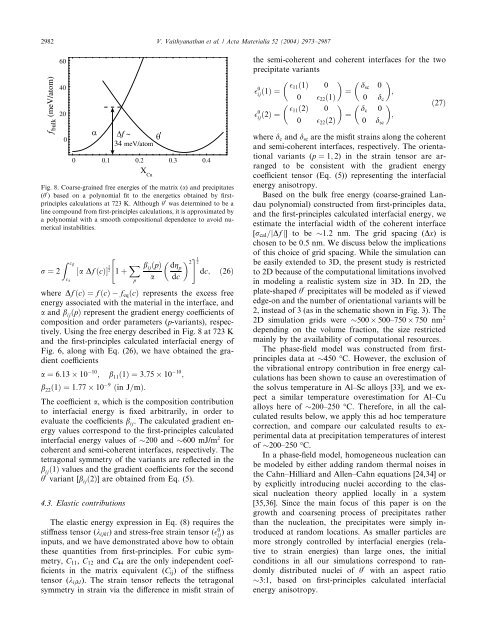Multiscale Modeling of Theta ' Precipitation in Al-Cu Binary Alloys
Multiscale Modeling of Theta ' Precipitation in Al-Cu Binary Alloys
Multiscale Modeling of Theta ' Precipitation in Al-Cu Binary Alloys
Create successful ePaper yourself
Turn your PDF publications into a flip-book with our unique Google optimized e-Paper software.
2982 V. Vaithyanathan et al. / Acta Materialia 52 (2004) 2973–2987<br />
the semi-coherent and coherent <strong>in</strong>terfaces for the two<br />
precipitate variants<br />
<br />
0 ij ð1Þ ¼ <br />
11ð1Þ 0<br />
¼ d <br />
sc 0<br />
;<br />
0 22 ð1Þ 0 d c<br />
<br />
0 ij ð2Þ ¼ <br />
11ð2Þ 0<br />
¼ d <br />
ð27Þ<br />
c 0<br />
;<br />
0 22 ð2Þ 0 d sc<br />
Fig. 8. Coarse-gra<strong>in</strong>ed free energies <strong>of</strong> the matrix (a) and precipitates<br />
(h 0 ) based on a polynomial fit to the energetics obta<strong>in</strong>ed by firstpr<strong>in</strong>ciples<br />
calculations at 723 K. <strong>Al</strong>though h 0 was determ<strong>in</strong>ed to be a<br />
l<strong>in</strong>e compound from first-pr<strong>in</strong>ciples calculations, it is approximated by<br />
a polynomial with a smooth compositional dependence to avoid numerical<br />
<strong>in</strong>stabilities.<br />
Z "<br />
cb<br />
r ¼ 2 ½a Df ðcÞŠ 1 2<br />
1 þ X #1<br />
<br />
b ij ðpÞ dg 2 2<br />
p<br />
dc; ð26Þ<br />
c a<br />
a dc<br />
p<br />
where Df ðcÞ ¼f ðcÞ f eq ðcÞ represents the excess free<br />
energy associated with the material <strong>in</strong> the <strong>in</strong>terface, and<br />
a and b ij ðpÞ represent the gradient energy coefficients <strong>of</strong><br />
composition and order parameters (p-variants), respectively.<br />
Us<strong>in</strong>g the free energy described <strong>in</strong> Fig. 8 at 723 K<br />
and the first-pr<strong>in</strong>ciples calculated <strong>in</strong>terfacial energy <strong>of</strong><br />
Fig. 6, along with Eq. (26), we have obta<strong>in</strong>ed the gradient<br />
coefficients<br />
a ¼ 6:13 10 10 ; b 11 ð1Þ ¼3:75 10 10 ;<br />
b 22 ð1Þ ¼1:77 10 9 ð<strong>in</strong> J=mÞ:<br />
The coefficient a, which is the composition contribution<br />
to <strong>in</strong>terfacial energy is fixed arbitrarily, <strong>in</strong> order to<br />
evaluate the coefficients b ij . The calculated gradient energy<br />
values correspond to the first-pr<strong>in</strong>ciples calculated<br />
<strong>in</strong>terfacial energy values <strong>of</strong> 200 and 600 mJ/m 2 for<br />
coherent and semi-coherent <strong>in</strong>terfaces, respectively. The<br />
tetragonal symmetry <strong>of</strong> the variants are reflected <strong>in</strong> the<br />
b ij ð1Þ values and the gradient coefficients for the second<br />
h 0 variant [b ij ð2Þ] are obta<strong>in</strong>ed from Eq. (5).<br />
4.3. Elastic contributions<br />
The elastic energy expression <strong>in</strong> Eq. (8) requires the<br />
stiffness tensor (k ijkl ) and stress-free stra<strong>in</strong> tensor ( 0 ij )as<br />
<strong>in</strong>puts, and we have demonstrated above how to obta<strong>in</strong><br />
these quantities from first-pr<strong>in</strong>ciples. For cubic symmetry,<br />
C 11 , C 12 and C 44 are the only <strong>in</strong>dependent coefficients<br />
<strong>in</strong> the matrix equivalent (C ij ) <strong>of</strong> the stiffness<br />
tensor (k ijkl ). The stra<strong>in</strong> tensor reflects the tetragonal<br />
symmetry <strong>in</strong> stra<strong>in</strong> via the difference <strong>in</strong> misfit stra<strong>in</strong> <strong>of</strong><br />
where d c and d sc are the misfit stra<strong>in</strong>s along the coherent<br />
and semi-coherent <strong>in</strong>terfaces, respectively. The orientational<br />
variants (p ¼ 1; 2) <strong>in</strong> the stra<strong>in</strong> tensor are arranged<br />
to be consistent with the gradient energy<br />
coefficient tensor (Eq. (5)) represent<strong>in</strong>g the <strong>in</strong>terfacial<br />
energy anisotropy.<br />
Based on the bulk free energy (coarse-gra<strong>in</strong>ed Landau<br />
polynomial) constructed from first-pr<strong>in</strong>ciples data,<br />
and the first-pr<strong>in</strong>ciples calculated <strong>in</strong>terfacial energy, we<br />
estimate the <strong>in</strong>terfacial width <strong>of</strong> the coherent <strong>in</strong>terface<br />
[r cal =jDf j] to be 1.2 nm. The grid spac<strong>in</strong>g (Dx) is<br />
chosen to be 0.5 nm. We discuss below the implications<br />
<strong>of</strong> this choice <strong>of</strong> grid spac<strong>in</strong>g. While the simulation can<br />
be easily extended to 3D, the present study is restricted<br />
to 2D because <strong>of</strong> the computational limitations <strong>in</strong>volved<br />
<strong>in</strong> model<strong>in</strong>g a realistic system size <strong>in</strong> 3D. In 2D, the<br />
plate-shaped h 0 precipitates will be modeled as if viewed<br />
edge-on and the number <strong>of</strong> orientational variants will be<br />
2, <strong>in</strong>stead <strong>of</strong> 3 (as <strong>in</strong> the schematic shown <strong>in</strong> Fig. 3). The<br />
2D simulation grids were 500 500–750 750 nm 2<br />
depend<strong>in</strong>g on the volume fraction, the size restricted<br />
ma<strong>in</strong>ly by the availability <strong>of</strong> computational resources.<br />
The phase-field model was constructed from firstpr<strong>in</strong>ciples<br />
data at 450 °C. However, the exclusion <strong>of</strong><br />
the vibrational entropy contribution <strong>in</strong> free energy calculations<br />
has been shown to cause an overestimation <strong>of</strong><br />
the solvus temperature <strong>in</strong> <strong>Al</strong>–Sc alloys [33], and we expect<br />
a similar temperature overestimation for <strong>Al</strong>–<strong>Cu</strong><br />
alloys here <strong>of</strong> 200–250 °C. Therefore, <strong>in</strong> all the calculated<br />
results below, we apply this ad hoc temperature<br />
correction, and compare our calculated results to experimental<br />
data at precipitation temperatures <strong>of</strong> <strong>in</strong>terest<br />
<strong>of</strong> 200–250 °C.<br />
In a phase-field model, homogeneous nucleation can<br />
be modeled by either add<strong>in</strong>g random thermal noises <strong>in</strong><br />
the Cahn–Hilliard and <strong>Al</strong>len–Cahn equations [24,34] or<br />
by explicitly <strong>in</strong>troduc<strong>in</strong>g nuclei accord<strong>in</strong>g to the classical<br />
nucleation theory applied locally <strong>in</strong> a system<br />
[35,36]. S<strong>in</strong>ce the ma<strong>in</strong> focus <strong>of</strong> this paper is on the<br />
growth and coarsen<strong>in</strong>g process <strong>of</strong> precipitates rather<br />
than the nucleation, the precipitates were simply <strong>in</strong>troduced<br />
at random locations. As smaller particles are<br />
more strongly controlled by <strong>in</strong>terfacial energies (relative<br />
to stra<strong>in</strong> energies) than large ones, the <strong>in</strong>itial<br />
conditions <strong>in</strong> all our simulations correspond to randomly<br />
distributed nuclei <strong>of</strong> h 0 with an aspect ratio<br />
3:1, based on first-pr<strong>in</strong>ciples calculated <strong>in</strong>terfacial<br />
energy anisotropy.
















